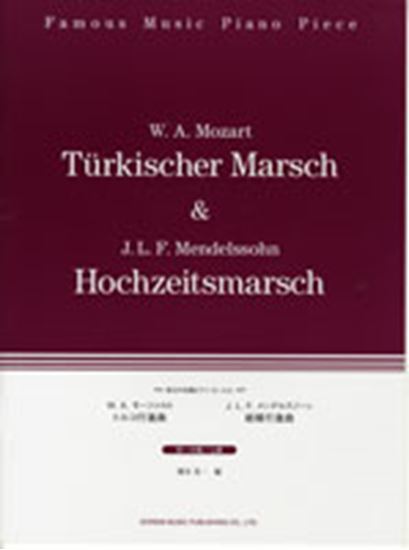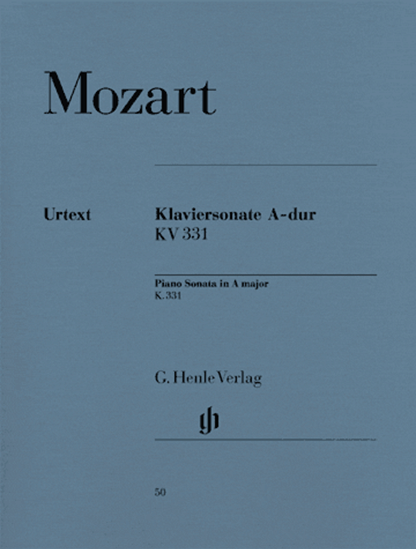Mozart, Wolfgang Amadeus : Sonate für Klavier Nr.11 A-Dur K.331 K6.300i
Work Overview
Publication Year:1784
First Publisher:Artaria
Instrumentation:Piano Solo
Genre:sonata
Total Playing Time:23 min 30 sec
Copyright:Public Domain
Commentary (1)
Author : Okada, Akihiro
Last Updated: November 1, 2009
[Open]
Author : Okada, Akihiro
As stated in the entry for K. 330, this sonata was also previously thought to have been composed in Paris, but recent research has identified it as a work from around 1783.
Vienna around 1783, when this work is believed to have been composed, marked the 100th anniversary of the Habsburg victory over the Ottoman army in the Siege of Vienna. The Turkish March in the final movement is thus thought to reflect these prevailing social conditions.
Although none of the movements contain sonata form, all movements are in the same tonic key, which can be seen to retain traces of the sonata da chiesa. Furthermore, the movement structure, beginning with variations, followed by a dance movement, and then a march, undoubtedly had a significant influence on Beethoven's "Funeral March Sonata," Op. 26.
First Movement: A major, 6/8 time, Variations
The barcarolle-like theme, based on three voices, has repeat signs for both its first eight-measure half and its subsequent ten-measure half.
In the first variation, the upper voice figuration is decoratively varied, and in the second variation, the theme's melody is again decoratively varied, primarily against an accompaniment of sixteenth-note triplets.
The third variation shifts to the parallel minor (A minor), and the ornamental figuration, which previously contained rests, is now replaced by continuous ascending and descending scalic ornamentation. One could also consider this figuration to have an affinity with the motif of the third movement.
From the fourth variation, the tonality returns to the tonic key, and the left hand, with crossed hands, handles both the bass and the melody. Such virtuosic and visual elements must have been important aspects of variations.
In the fifth variation, the tempo is lowered to Adagio for the first time, creating a striking contrast with the acrobatic fourth variation. The melody is adorned with even finer ornamentation before leading into the sprightly sixth variation. The meter changes to 4/4 time and the tempo to Allegro, incorporating all manner of ornamental techniques, such as circling figurations, arpeggios, and scale passages, to conclude the movement. It can be observed that the circling figuration at the beginning of this variation is foundational to the march theme of the final movement.
Second Movement: A major, 3/4 time, Minuet
Both the Minuet and the Trio are composed in binary form, with repeat signs for their respective first and second halves.
The Minuet theme recalls the opening theme of K. 309's first movement. The passage in sixteenth notes leads to a close in the dominant key in the first half, but this passage appears in the tonic key in the second half.
The Trio modulates to the subdominant key of D major. The first half features stepwise motion in parallel thirds and sixths, while in the second half, the Trio theme first appears in E minor and then develops into a resolute descending figuration in a four-octave unison. Utilizing motifs from the second half of the Minuet's main section, the Trio theme recurs in D major after passing through C major, F major, and D minor.
Such a tonal structure in binary form, and the development of the theme in the Trio section, closely approach sonata form.
Third Movement: A minor - A major, 2/4 time, Turkish March
This march, marked "Alla Turca" at the beginning, is arguably Mozart's most popular work.
It begins with a melody characterized by a circling figuration in A minor, which then, after a combination of stepwise ascending and descending motion in parallel thirds in C major (the relative major) (mm. 9ff.), develops into military march-like music in A major (the parallel major of the tonic key) (mm. 25ff.).
Subsequently, a passage of sixteenth notes appears, beginning with an inversion of the opening circling figuration in F-sharp minor (the relative minor of A major) (mm. 33ff.).
After this passage, the A major military march is interspersed again, and the opening circling figuration theme recurs in A minor (mm. 65ff.). After recapitulating the C major section (mm. 73ff.) and the A major section (mm. 89ff.), the movement concludes brilliantly with an extended coda based on the A major military march, recalling the inversion of the circling figuration.
Movements (3)
Mov.1 Theme and variations-Andante grazioso
Total Performance Time: 13 min 30 sec
Arrangements & Related Works(9) <Show>
yamaha music foundation & yamaha music media corporation: 大人のためのピアノ悠々塾 初級編 改訂版 トルコ行進曲(モーツァルト、ヤマハ編)
Total Performance Time: 1 min 10 sec
Mozart, Wolfgang Amadeus: Mov.1 Theme and variations-Andante grazioso
Total Performance Time: 11 min 00 sec
PTNA & Partner Channel Videos(21items) View More
Sheet MusicView More
Scores List (144)

(株)エー・ティ・エヌ

(株)エー・ティ・エヌ

(株)エー・ティ・エヌ

(株)全音楽譜出版社

(株)全音楽譜出版社

(株)ヤマハミュージックエンタテインメントホールディングス

ハンナ(ショパン)

(株)全音楽譜出版社

(株)ドレミ楽譜出版社

(株)全音楽譜出版社

(株)ドレミ楽譜出版社

(株)春秋社

(株)全音楽譜出版社

(株)全音楽譜出版社

(株)全音楽譜出版社

(株)全音楽譜出版社

(株)全音楽譜出版社

(株)全音楽譜出版社

(株)全音楽譜出版社

(株)リットーミュージック

(株)ドレミ楽譜出版社

KMP(ケイ・エム・ピー) ケイエムピー

(株)音楽之友社

KMP(ケイ・エム・ピー) ケイエムピー

(株)サーベル社

ミュージックランド

(株)サーベル社

カワイ出版

ミュージックランド

(株)タイムリーミュージック

(株)ドレミ楽譜出版社

(株)共同音楽出版社

(株)タイムリーミュージック

(株)全音楽譜出版社

ミュージックランド

KMP(ケイ・エム・ピー) ケイエムピー

KMP(ケイ・エム・ピー) ケイエムピー

ミュージックランド

(株)ドレミ楽譜出版社

ミュージックランド

(株)シンコーミュージックエンタテイメント

ミュージックランド

(株)共同音楽出版社

(株)ドレミ楽譜出版社

(株)学研プラス

ミュージックランド

(株)タイムリーミュージック

KMP(ケイ・エム・ピー) ケイエムピー

(株)リットーミュージック

ミュージックランド

(株)ドレミ楽譜出版社

(株)シンコーミュージックエンタテイメント

(株)リットーミュージック

ミュージックランド

ミュージックランド

(株)リットーミュージック

ミュージックランド

(株)シンコーミュージックエンタテイメント

(株)リットーミュージック

ミュージックランド

(株)ヤマハミュージックエンタテインメントホールディングス

(株)ヤマハミュージックエンタテインメントホールディングス

(株)ドレミ楽譜出版社

(株)ドレミ楽譜出版社

(株)ヤマハミュージックエンタテインメントホールディングス

(株)シンコーミュージックエンタテイメント

(株)オンキョウパブリッシュ〇

(株)ヤマハミュージックエンタテインメントホールディングス

(株)シンコーミュージックエンタテイメント

ハンナ(ショパン)

ミュージックランド

ミュージックランド

(株)ドレミ楽譜出版社

(株)シンコーミュージックエンタテイメント

(株)シンコーミュージックエンタテイメント

(株)シンコーミュージックエンタテイメント

ハンナ(ショパン)

(株)ドレミ楽譜出版社

(株)シンコーミュージックエンタテイメント

(株)シンコーミュージックエンタテイメント

ハンナ(ショパン)

ハンナ(ショパン)

ハンナ(ショパン)

(株)ヤマハミュージックエンタテインメントホールディングス

KMP(ケイ・エム・ピー) ケイエムピー

ハンナ(ショパン)

ハンナ(ショパン)

KMP(ケイ・エム・ピー) ケイエムピー

KMP(ケイ・エム・ピー) ケイエムピー

(株)シンコーミュージックエンタテイメント

成美堂出版(株)

(株)タイムリーミュージック

ハンナ(ショパン)

(株)ヤマハミュージックエンタテインメントホールディングス

(株)ヤマハミュージックエンタテインメントホールディングス

ミュージックランド

(株)ヤマハミュージックエンタテインメントホールディングス

(株)ドレミ楽譜出版社

ミュージックランド

(株)シンコーミュージックエンタテイメント

(株)ヤマハミュージックエンタテインメントホールディングス

(株)全音楽譜出版社

(株)全音楽譜出版社

ミュージックランド

(株)ヤマハミュージックエンタテインメントホールディングス

ミュージックランド

(株)ドレミ楽譜出版社

(株)シンコーミュージックエンタテイメント

(株)シンコーミュージックエンタテイメント

(株)シンコーミュージックエンタテイメント

ミュージックランド

(株)シンコーミュージックエンタテイメント

(株)ドレミ楽譜出版社

(株)シンコーミュージックエンタテイメント

ミュージックランド

(株)自由現代社

(株)ヤマハミュージックエンタテインメントホールディングス

(株)全音楽譜出版社

(株)全音楽譜出版社

(株)音楽之友社

ヘンレ社(ヤマハ)

(株)全音楽譜出版社

(株)全音楽譜出版社

(株)ヤマハミュージックエンタテインメントホールディングス

(株)音楽之友社

(株)東音企画(バスティン)

(株)共同音楽出版社

(株)ヤマハミュージックエンタテインメントホールディングス

ハンナ(ショパン)

(株)学研プラス

Neil A. Kjos Music Company

EMB

Breitkopf & Hartel

Musikverlag Doblinger

(株)全音楽譜出版社



























